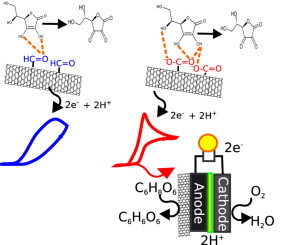International Journal of Hydrogen Energy ( IF 8.1 ) Pub Date : 2018-03-22 , DOI: 10.1016/j.ijhydene.2018.02.185 Andrés A. Arrocha-Arcos , M. Miranda-Hernández

|
Due to the significance of Ascorbic Acid (AA) fuel cells in biological systems and energy storage applications, the development of efficient electrochemical strategies is needed. In the present work, the electrochemical oxidation of AA is performed with Multiwalled Carbon Nanotubes (MWCNTs) anodes which have controlled oxygen content, modulated by acid reflux treatment. Furthermore, a total oxygen content increase of just 2% on MWCNTs surface was sufficient to achieve an enhanced AA electrocatalytic oxidation. The oxygen content was notoriously lower than other nanocarbon materials like unzipped carbon nanotubes and reduced graphene oxide which normally are considered as optimal materials. The surface chemical composition on MWCNTs was analyzed by XPS. The anodes were prepared as carbon film electrodes (CFE) by dropping cast procedure on GC surface (current collector). Cyclic voltammetry was used to evaluate the electrochemical responses of these electrode materials varying the concentration of AA (10, 50 and 100 mM). At a fixed concentration, the electrochemical responses show an increase in current and a shift of peak potential that facilitate oxidation as the acid treatment time increases. It was found that the COO− groups are responsible for the enhanced catalytic behavior of these modified MWCNTs. The simple change of functional groups by the same acid treatment procedure at different times has a notorious effect on AA oxidation. These findings provide straightforward selection criteria for anodes devoted to AA fuel cell design. Also, it is demonstrated that MWCNTs can still provide new alternatives for enhanced electrocatalytic processes.
中文翻译:

低氧含量的多壁碳纳米管阳极,用于抗坏血酸燃料电池设计
由于抗坏血酸(AA)燃料电池在生物系统和能量存储应用中的重要性,因此需要开发有效的电化学策略。在目前的工作中,AA的电化学氧化是通过多壁碳纳米管(MWCNT)阳极进行的,该阳极具有受控的氧含量,并通过酸回流处理进行了调节。此外,MWCNTs表面仅增加2%的总氧含量就足以实现增强的AA电催化氧化。众所周知,氧含量低于其他纳米碳材料,例如未压缩的碳纳米管和还原的氧化石墨烯,这些材料通常被认为是最佳材料。用XPS分析了MWCNTs的表面化学组成。通过在GC表面(集电器)上滴铸工艺将阳极制成碳膜电极(CFE)。循环伏安法用于评估这些电极材料在AA浓度(10、50和100 mM)变化下的电化学响应。在固定浓度下,随着酸处理时间的增加,电化学响应显示电流增加和峰电位移动,这有助于氧化。发现首席运营官-基团负责这些改性的MWCNT的增强的催化行为。通过相同的酸处理程序在不同时间简单改变官能团对AA氧化有臭名昭著的影响。这些发现为致力于AA燃料电池设计的阳极提供了直接的选择标准。而且,已经证明,MWCNT仍可以为增强的电催化过程提供新的替代方法。











































 京公网安备 11010802027423号
京公网安备 11010802027423号